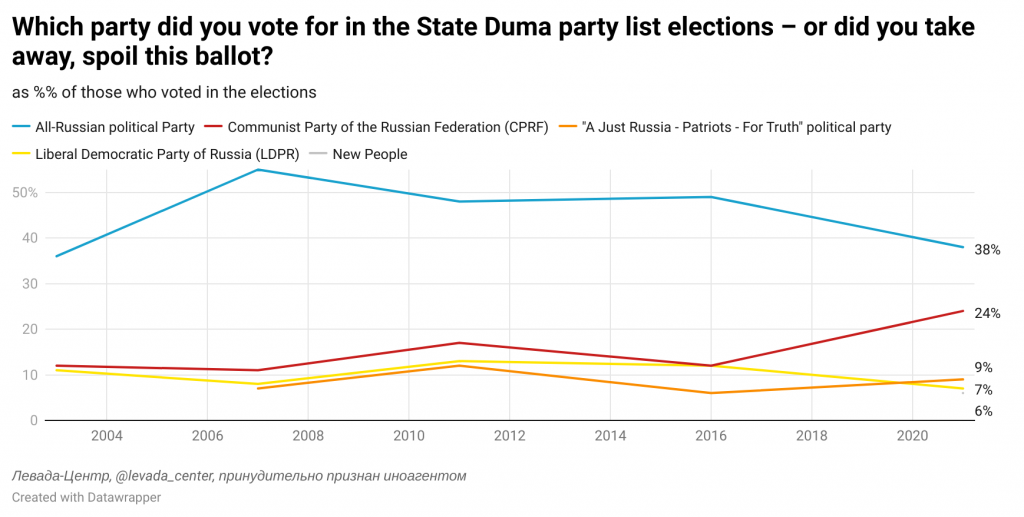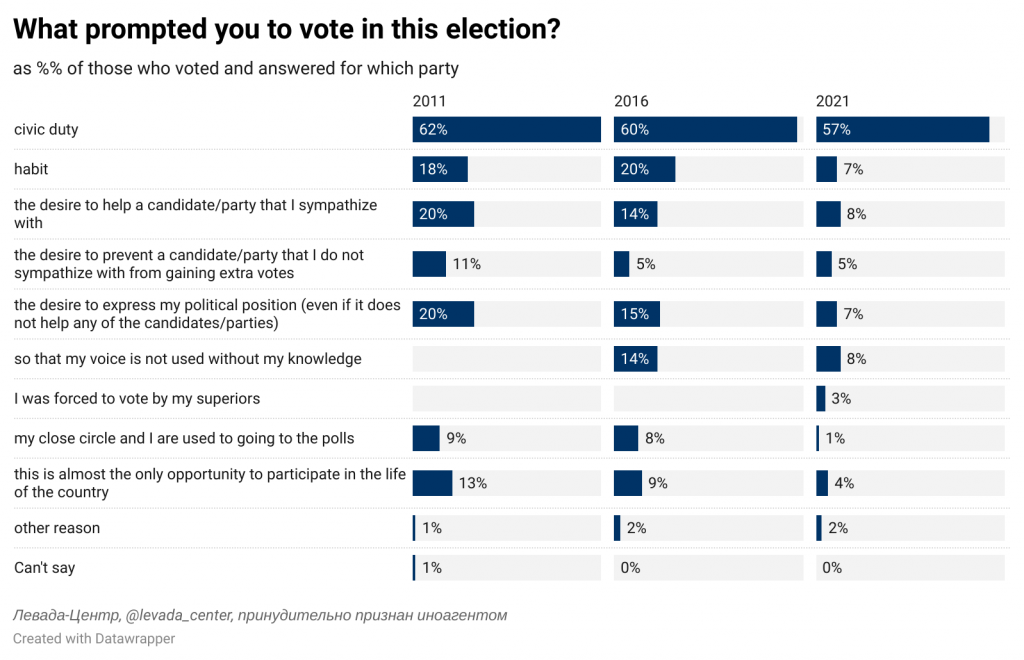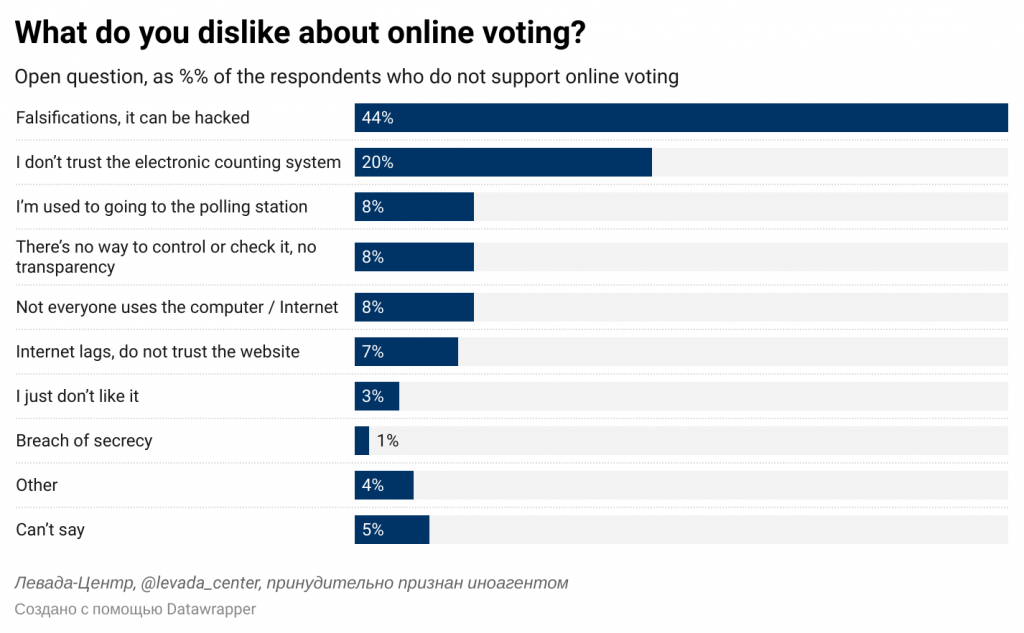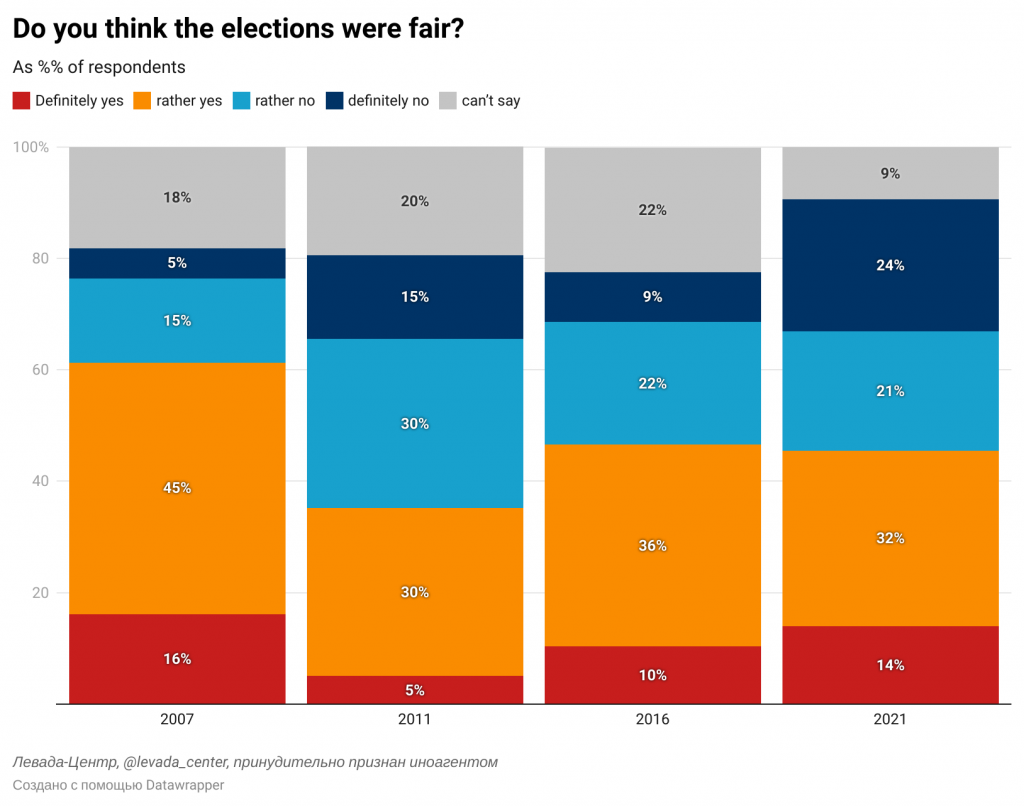Turnout
55% of Russians replied that they voted in the State Duma elections. This is slightly more than in 2016 (51%), but significantly less than in 2017 (70%).

Party list voting results
38% of Russians who voted said that they voted for United Russia, which is less than the numbers during the previous election. 24% replied that they voted for the Communist Party of Russia – that is two times more than in 2016 (12%) and the best result since 2003. 9% replied that they voted for “A Just Russia – Patriots – For Truth” – that is slightly better (within the margin of error) than in 2016 (6%). 7% admitted voting for the Liberal Democratic Party – this is 5% less than in 2016 and marks the worst result since 2003. 6% voted for the “New People” party. At the same time, 10% of respondents refused to name the party they voted for.

Which party did you vote for in the State Duma party list elections – or did you take away, spoil this ballot? (as %% of those who voted in the elections)
| All-Russian political Party “United Russia” | 38 |
| Communist Party of the Russian Federation (CPRF) | 24 |
| “A Just Russia – Patriots – For Truth” political party | 9 |
| Liberal Democratic Party of Russia (LDPR) | 7 |
| “New People” political party | 6 |
| Russian United Democratic Party “YABLOKO” | 1 |
| Communist Party “Communists of Russia” | 1 |
| The Russian ecological party “The Greens” | 1 |
| “Russian Party of Pensioners for Social Justice” | 1 |
| Ecological Party “The Green Alternative” | 1 |
| All-Russian political party “Party of Growth” | <1 |
| All-Russian political party “Rodina” | <1 |
| Russian Freedom and Justice Party | <1 |
| Civic Platform Political Party | <1 |
| took away, spoiled the ballot | 1 |
| I don’t remember/don’t want to answer | 10 |

More than a half of the voters (58%) decided which party to vote for long before the election campaign. This indicator has grown significantly since 2016 (44%). Only 7% of people decided on the election day – this number has not changed significantly since 2011.

The activity of the supporters of United Russia did not depend much on the voting day, the supporters of the Communist Party, on the contrary, grew more active by Sunday. Among those who voted on Friday, 47% voted for the United Russia, 13% for the Communist Party, on Saturday – 44% and 28%, respectively, on Sunday, September 19 – 40% and 32%, respectively. Overall, 22% of respondents voted on Friday and Saturday, 55% voted on Sunday.

The shares of party supporters do not change significantly depending on whether the respondents work in private businesses or in the government. Among public sector workers, 31% voted for the United Russia, 25% – for the Communist Party, among private sector workers – 32% and 26%, respectively.

Voting process
90% of people voted at ordinary polling stations – this is 14 percent more than in 2020 during the vote on the Constitutional amendments. 5% voted at home, 4% electronically.

More than a half of voters (55%) cast the ballots on September 19, 44% did that earlier. In 2020, more than a half (60%) voted before the last day of the election.

57% of those who voted did it because they consider it a civic duty, 8% – in an effort to help a particular candidate or party. Another 8% – to prevent their vote from abuse, 7% – out of habit (almost 3 times less than in 2016).

Among those who did not vote, 21% motivate their decision by the fact that they do not believe any of the current politicians. 17% could not get to the polling station for personal reasons, 10% are convinced that the election results do not depend on their participation. The top reasons have not changed in the last 10 years.

94% of respondents noted that they had not been forced to take part in elections or vote for a certain party.

TV debates
A third of Russians (32%) watched TV debates before the elections, 68% did not watch them. These indicators have not changed significantly since 2016.

As the parties whose representatives were most interesting, respondents noted United Russia (31%), the Communist Party (24%), the Liberal Democratic Party (24%), New People (18%) and A Just Russia(15%).

Among the speakers who were most memorable the respondents named V. Zhirinovsky (17%), G.Zyuganov (6%), S. Mironov (3%) and M. Shevchenko (2%).

Online voting
46% of Russians have a positive attitude to online voting, less people (41%) are negative about it.

Supporters of United Russia and New People like online voting the most – 60% for, 26% against, and 53% and 39%, respectively. The supporters of the Communist Party like online voting the least: only 25% are for it, while 67% are against.

Those in favour of online voting mainly note to the fact that it allows to vote from home (38%). Another 30% highlight the overall convenience and comfort of the procedure. 10% stress the aspect of saving time, 7% believe that it’s more fair, harder to rig and easier to count.

The opponents of online voting mainly stress the possibility of rigging and hacking (44%). Another 20% do not trust the procedure in general. 8% are used to voting in person at the polling station, another 8% indicate a lack of control and transparency of the procedure.

Three-day election
The majority of Russians (68%) support the three-day election this way or another. 27% are against it.

The supporters of United Russia and the Liberal Democratic Party have the best attitude towards the three-day election – 86% and 84%, respectively, support this measure. The supporters of the Communist Party are the least supportive of this measure: 52% for, 44% against.

Those who do not support the introduction of three-day voting point primarily to the possibility of fraud (39%). Another 33% believe that one day is enough.

What do Russians think about the election results?
46% of Russians somehow believe that the State Duma elections were fair, the same number of people (45%) think otherwise. In 2016, these figures were 46% and 31%, respectively.

Russians who participated in the election have more confidence in the election results – 56% of them believe that the elections were fair, 37% consider them rigged. Among non-voters the numbers are 34% and 54%, respectively.

The voters of United Russia are the most numerous group that trusts the election results: 84% think they were fair, 10% think they were rigged. Only 23% of CPRF voters think the election was fair, 70% distrust the results.

Satisfaction with the election results is much lower than in 2016. 46% of Russians are satisfied with the results (50% in 2016, 51% in 2011), 40% are not satisfied (27% in 2016, 35% in 2011). 9% are indifferent to the election results.

More than a half of voters (58%) are satisfied with the election results. 37% are not satisfied. Among non-voters the numbers are 31% and 43%, respectively.

The voters of United Russia are most satisfied with the election results: 92% are satisfied, 5% are not satisfied. The least satisfied are the voters of the Communist Party: 27% and 68% respectively.

49% of Russians expect the recent elections to change things for the better, the same number of people (48%) do not expect such changes. In 2016 these indicators were 45% and 47% respectively.

More than a half of voters (59%) expect things to change for the better, 38% do not expect positive changes. Among non-voters, only 37% expect positive changes while 59% do not.

The voters of United Russia expect positive changes the most – 87%, the voters of the Communist Party expect them the least – 31%.

Half of Russians (51%) believe that their interests will be represented in the Duma. 39% are sure that there will be no party representing their interests. In 2016, these figures were 47% and 30%, respectively.

Among the voters, 72% are sure that their interests will be represented by a party in the State Duma, 23% believe the opposite. Among non-voters, only 27% think their interests will be represented, 58% believe they will not be represented.

Методология
This survey was conducted September 23 – 29 2021, among a representative sample of all Russian urban and rural residents. The sample consisted of 1634 people aged 18 or older in 137 municipalities of 50 regions of the Russian Federation. The survey was conducted as a personal interview in respondents’ homes. The answer distribution is presented as percentages of the total number of participants along with data from previous surveys.
The statistical error of these studies for a sample of 1600 people (with a probability of 0.95) does not exceed:
3.4% for indicators around 50%
2.9% for indicators around 25%/75%
2.0% for indicators around 10%/90%
1.5% for indicators around 5%/95%
The ANO Levada Center has been included in the registry of non-commercial organizations acting as foreign agents.


